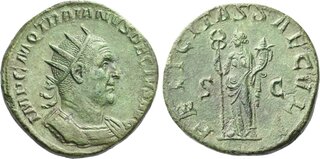| Numismatica Ars Classica > Auction 144 with CNG & NGSA | Auction date: 8 May 2024 |
| Lot number: 1147 Price realized: This lot is for sale in an upcoming auction - Bid on this lot  | Show similar lots on CoinArchives Find similar lots in upcoming auctions on |
| Lot description: The Geoffrey Cope Collection of Ancient Greek and Roman Bronzes. The Roman Empire. Trajan Decius augustus, 249 – 251. Description Double sestertius, Roma 249-251, Æ 33 mm, 28.29 g. IMP C M Q TRAIANVS DECIVS AVG Radiate, draped and cuirassed bust r. Rev. FELICITAS SAECVLI S – C Felicitas standing l., holding caduceus and cornucopia. Reference C 39 RIC 115a Condition A superb portrait and a lovely light green patina. Extremely fine Provenance NAC sale 8, 1995, 913 M&M Fixed Price List 591, 1995, 94 For an emperor who came to the throne through rebellion and inherited the overwhelming political, economic, and military chaos of the age, it is remarkable that Trajan Decius had any interest in reforming the aes coinage. The brevity of his reign and the instability that followed the massacre of Decius' army by the Goths, assured there was no easy path for his reform to take root. But even if Decius had ruled for a lengthy period, it likely would have failed, for the integrity of the coinage continued its precipitous slide. Indeed, by the reign of Decius the intrinsic value of the double-denarius had fallen enough for it to be practical to strike new double-denarii over Severan denarii without concern for a perceived reduction in value. Like his immediate predecessors, Decius continued to strike the sestertius in large quantities and the dupondius and as on a modest scale. However, he expanded the repertoire of aes coinage with a double-sestertius and a small copper piece, usually called a semis, but which may have been a reduced-weight aes. His other numismatic creation was a series of double-denarii portraying eleven of Rome's deified emperors, from Augustus though Severus Alexander, which presumably was meant to celebrate the state religion, which included emperor worship. The novelty of the series – unparalleled by anything other than the 'restored' coinage of his adopted namesake, Trajan – seems a frivolous luxury in this difficult era. Perhaps even more interesting is his selection of emperors since, for example, he omits Claudius yet includes Commodus. Both choices defy explanation from a modern point of view, yet they likely reflected common opinion at the time. Estimate: 5000 CHF |  |



